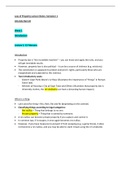Law of Property Lecture Notes: Semester 1
Amanda Barratt
Week 1
Introduction
Lecture 1: 15 February
Introduction
• Property law is “the incredible machine” – you can know and apply the rules, and you
will get inevitable results.
• However, property law is also political – it can be a source of violence (e.g. evictions).
• The constitution is supposed to protect everyone’s rights, particularly those who are
marginalised and subjected to this violence.
• Two introductory cases:
- Eastern Cape Parks Board v Le Roux (illustrates the importance of “things” in Roman-
Dutch law).
- Minister of Housing v City of Cape Town and Others (illustrates that property law is
inherently violent, the rei vindicatio can have a devasting human impact).
What is a thing
• Latin word for thing = Res, Rem, Rei and Re (depending on the context).
• Classifying things according to legal categories:
- Res nullius = Thing that belongs to no one.
- Private property = Thing that is owned by someone.
• A res nullius can become private property if you capture and control it.
• In common law, if it escapes, it once again becomes res nullius.
• However, if you have measures to prevent it from escaping (e.g. a game fence), it does
not become a res nullius, and you may be able to claim it back using the rei vindicatio.
,Lecture 2: 17 February
Situating the Law of Property in the Legal System
• Patrimonial law (property and succession) often comes into play in the law of persons
and family, and vice versa.
• It is true that property law can be thought of an the intersection between private law
and public law. However, It is inaccurate to think of private law as something that is
shielded – it is also very political.
Sources of South African Property Law
• Roman-Dutch common law (this is very obvious, property law makes attempts to use the
rules of Roman law).
• Apartheid law (it was an official source of law during Apartheid, all statutes have since
been repealed but this does not mean that the long-term impacts are not still seen, a lot
of attempts to transform property relations in SA are reacting to its legacy).
• African customary law (in practice, it is mostly used in rural areas).
• Legislation (Acts of Parliament).
• The Constitution.
Roman-Dutch Common Law as a Source of Property Law
• Roman law rules are alive and well even today (e.g. classification of “res nullius” and
remedies like “rei vindicatio”).
• After the fall of Roman, there was a certain level of survival of the Roman law system, as
reinterpreted in Europe.
• It was influenced by Germanic customary law and Canon law (drawn up by Voet, Grotius
and other “old authorities”, statutory amendments in Holland).
• It was systemised in a relentlessly logical way by German Pandectism in the 19 th century.
• It places strong emphasis on the powerful real right – in today’s context, this is criticised.
, • Ownership of land (most powerful real right):
- Contractual agreement to use land (right in personam = personal right).
- Servitude rights to the land (right in rem = property right, registered on a title deed
in the Deeds Office).
• Roman-Dutch law became a part of SA law with the arrival of Jan van Riebeek in 1652.
• By 1795, the Dutch had colonised as far as Graaf Reinet (in the Eastern Cape), but their
impact was relatively contained.
• In 1806, SA became part of the British Empire and was, in many ways, never the same
thereafter (in terms of the content and uses of the law).
• The British arrived for the strategic reason to protect the trade route to India.
• They were not impressed with Dutch rule and made several changes (e.g. freed the
slaves in 1838 and set up a more organised English justice system, i.e. courts).
• The way the distribution of land in SA looks now began in the colonial era.
• In the 1870s to the 1880s, extremely successful peasantry arose in the Eastern Cape.
• The white farmers were resentful that the peasantry was able to outperform them and
that the peasantry refused to work for them, because they could work for themselves
and have a successful family farm.
• The discovery of diamonds (1867) and gold (1886) resulted in the mineral revolution.
• Cecil John Rhodes was responsible for much of the injustices during this time. He
suggested building closed compounds on the mines (modelled off prisons) and put
pressure on the government to make suitable rules that would persuade people to work
on the mines (primarily, taking away their land, thereby making it impossible for the
thriving peasantry to continue).
• Most of the land was expropriated in a violent way.
• The British did not always win the conflict this created (e.g. Isandlwana in January 1979)
and sometimes, people were able to negotiate successfully (e.g. King Moshoeshoe, in
what became Lesotho, was able to retain a measure of economic/political independence
that continues to this day).
• However, ultimately, people were dispossessed off their land.
• In 1913, only 9% of the land was set aside for Africans, and by 1936, slightly more land
(11%) was set aside with the Development and Trust Land Act.
Apartheid Law as a Source of Property Law
• The Apartheid territories made up 13% of all land (millions of people were squashed on
this small amount of land).
• African people were absolutely depend on migrant labour and had to travel into “white
SA” to find work, mostly on the mines.
• In the Apartheid territories, land was not owned according to Roman-Dutch law rules, as
it was owned in “white SA”. The system of access to the land was modelled on official
customary law (not necessarily the true customary law that had been practiced before




